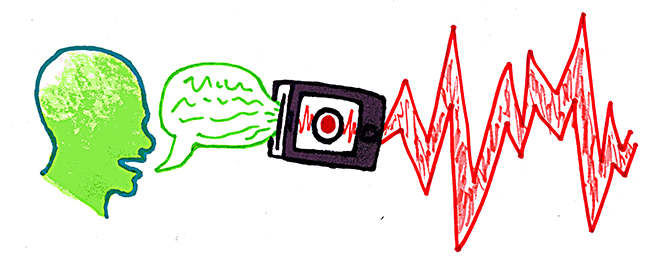Most people are familiar with the grimace-inducing moment they listen to a recording of their own voice, making it hard to hear the ugly truth — those YouTube videos and Snapchats are exactly what they sound like to everyone else.
“That’s really what your voice sounds like, unfortunately,” said Bharath Chandrasakeran, communication sciences and disorders assistant professor. ”Recordings are a very faithful representation of what other people hear.”
While some may dislike their voices when they’re exposed to recordings of them, routinely listening to these initially uncomfortable recordings can help people grow to embrace the sound of their voices.
Plan II senior Ehigbor Idonor said she is usually surprised by the way she sounds in recordings.
“When I’m speaking, I have no issue with my voice,” Idonor said. “But when I hear a recording, my voice sounds really stupid. Like, does my voice really sound like that?”
Chandrasekaran said this perceived difference reflects sound’s transmission into the inner ear through two distinct pathways. When a sound is produced by an external source, it will reach a person’s ear through “air conduction” — pressure waves created in the air. When a person produces sound internally, “bone conduction” also comes into play.
“Bone conduction directly transfers the vibrations produced by the vocal folds, through the bones in the skull, and into the inner ear,” Chandrasakeran said.
The overlap of bone conduction and air conduction affects the way a person hears themselves. Craig Champlin, a communication sciences and disorders professor, said bones enhance lower-frequency vibrations and give a person’s voice a deeper quality that’s lacking from external sounds.
“When you cover your ears you completely block out the air conduction pathway,” Champlin said. “The quality of your voice that gets into your ear through bone conduction is noticeably different.”
Voice recordings generally use air conduction only and therefore lack the more sonorant quality people are used to hearing along with their voices when they speak. People dislike their own voices in recordings because, when the bone conducted version of their voices is absent, what they hear doesn’t quite sound like what they expect.
“It just sounds unfamiliar,” Champlin said. “It sounds like, maybe not a different person talking, but maybe your younger sibling with a higher pitched voice."
A well-researched psychological phenomenon, the mere-exposure hypothesis predicts people prefer what they see and encounter most often.
“The only people who say they like the way they sound are often people who’ve made it their business to listen to themselves — broadcasters, vocal musicians,” Champlin said.
The silver lining is, while some people may dislike recorded versions of their own voice, friends and family who’ve grown familiar with their external voice won’t give it a second thought.
Researchers have explored the mere-exposure effect through the way people perceive themselves in non-mirrored pictures. Since people are regularly exposed to images of themselves in reflective surfaces, such as windows and mirrors, when this image is flipped in pictures it looks wrong because people are so accustomed to the mirrored version
of themselves.
According to an experiment conducted at the University of Wisconsin, Milwaukee in 1977 when people were presented with photos of their true image and their mirror image, participants preferred the mirror image while friends and romantic partners preferred the true image.
Similarly, familiarity seems to push people toward a preference for their internal voice.
“I’d prefer my internal voice over my external voice.” Champlin said. “It’s not that I don’t like it, but it’s more of a preference. I like ice cream — all ice cream is good. But I’d take chocolate over vanilla, and I’d take my in internal voice over my external voice.”





















